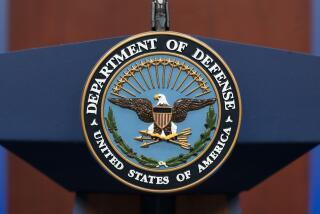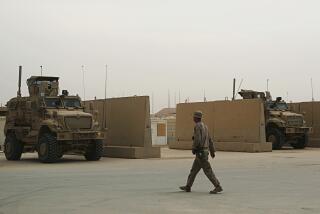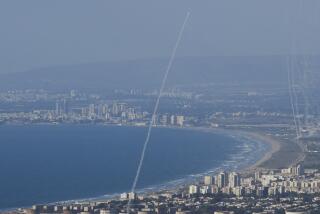U.S. to Call 40,000 Reservists : Gulf crisis: Bush will act today to meet a shortage of specialists, Pentagon officials say. The final figure could reach 150,000. Most will be stationed at domestic posts.
WASHINGTON — President Bush, moving to address critical shortages of cargo handlers and other personnel needed in the Middle East military buildup, will authorize today the mobilization of about 40,000 reservists, Pentagon officials said Tuesday.
The initial call-up of reservists, most of whom will be assigned to bases in the United States, is the first installment in a deployment that ultimately could grow to as many as 150,000 personnel, officials said.
Although White House officials said the President had agreed in principle to the call-up last Friday, the final decision was delayed so that the Pentagon could match its vacancies with available military specialists.
The officials acknowledged, however, that the delay also reflected a desire on the part of the Administration to prepare for the public impact of the announcement, which will disrupt the lives of the reservists, their families and communities across the nation.
Pentagon officials said the call-up is needed to provide specialty functions, such as cargo handling and medical support, that have been trimmed from active-duty forces during a gradual restructuring of the armed services over the last decade.
Most of the 40,000 will be Army reservists, but smaller contingents of Air Force and Navy reservists also will be included in the call-up, officials said. Although some units will no doubt be sent to the Middle East, most will be stationed at domestic ports and military posts.
Although the mobilization is relatively large, it falls far short of Pentagon requests. The Army had proposed a call-up of about 80,000 reserves, and the Air Force and Navy had sought smaller deployments of about 35,000 each.
“Forty-thousand helps, but it’s not enough,” said a high-ranking military official, who asked not to be named. “What we didn’t get, we’ll have to take out of actives (active-duty forces) or out of Europe.”
The reserves units will join a growing military buildup that already involves about 35,000 troops on the ground in the Middle East and tens of thousands more in transit. Officials have said the Middle East deployment is expected to top 100,000 by mid-September.
The Pentagon, meanwhile, reported that the United States has moved the equivalent of a small Midwestern city to the Middle East in the last 19 days--complete with all of the necessary foodstuffs, vehicles and belongings.
Air Force Gen. H. T. Johnson, commander of the U.S. Transportation Command and Military Airlift Command, said the massive movement of military personnel and equipment in less than three weeks is the largest operation of its kind in U.S. history.
Even in the absence of a formal reserve call-up, he said, about 4,200 military reservists have volunteered to fly the 89 C-5s and 195 C-141s that are being used in the airlift. In addition, 17 commercial airliners and 21 civilian cargo planes have been pressed into service.
Despite the significant volunteer effort, Johnson said military reserve units are needed because most volunteers could not be away from their jobs in private industry for more than 45 days.
Administration officials acknowledged that yanking neighborhood doctors and grocery clerks from their communities and sending them to war can be a wrenching experience, not just for the individuals and their communities but for the nation as a whole.
As part-time reservists are called up to become full-time soldiers, small towns and big cities alike will come to grips with the human dimensions of the crisis and the impact it can have across the continent, they noted.
Bush’s assistants have said the President was nearly certain as of last Friday that he would call up reserve units. Officials said the paper work to activate the reserves lacked only a presidential signature.
But they said the Administration decided to delay the final step while complex preparations are still under way. The goal was to try to avoid confusion and minimize further delays once the decision is announced.
“There’s just a lot of detail,” one senior White House official said. “When it is signed, all these people are going to be told what is expected of them. You want them to be able to get a definite word one way or the other. You’re dealing with people’s lives and their employment.”
Defense Secretary Dick Cheney and Gen. Colin L. Powell, chairman of the Joint Chiefs of Staff, are set to meet with Bush today in Kennebunkport, Me. Among other topics, they are expected to discuss the reserve call-up, White House Press Secretary Marlin Fitzwater said.
At the Pentagon, Gen. Johnson told a news briefing that the military, with help from reserve volunteers and the private sector, has transported the equivalent of Fayette, Ind., population 27,500, or Jefferson City, Mo., population 36,000, to the Persian Gulf.
The 1 billion pounds of material transported or still en route to the region is equal to all the cars, trucks, foodstuff, stocks, household goods and water supply of a small city, he told reporters.
“We’re fortunate we didn’t have to fight our way in,” Johnson said. “We’ve had no major surprises.”
He said the airlift initially strained the military’s capacity as the United States hurried combat units to the Persian Gulf after Iraq’s Aug. 2 invasion of Kuwait. But in recent days the operation has relied more on ships, which have spare capacity, Johnson said.
Most tanks and military vehicles have been rushed overseas aboard eight “fast sealift” ships capable of speeds up to 33 knots. The operation also involved unloading 12 Navy vessels pre-positioned in the Indian Ocean and stocked with ammunition, fuel, food and medical supplies.
The Pentagon also has activated 38 ships from its “ready reserve fleet” and chartered eight ships from commercial lines, Johnson said.
Johnson declined to divulge the specific number of troops or military vehicles that have been put into place in Saudi Arabia.
But he said 99% of all U.S. troops have been flown to the gulf in C-5 Galaxy and C-141 Starlifter transports. The trip takes 15 hours from the East Coast and about 20 hours from the West Coast.
Participation by commercial air carriers began last Friday when Johnson activated a program known as the Civil Reserve Air Fleet for the first time since its inception in 1951, at the time of the Korean War.
Gerstenzang reported from Kennebunkport and Jackson from Washington. Times staff writer Robert L. Jackson in Washington contributed to this report.
More to Read
Sign up for Essential California
The most important California stories and recommendations in your inbox every morning.
You may occasionally receive promotional content from the Los Angeles Times.










